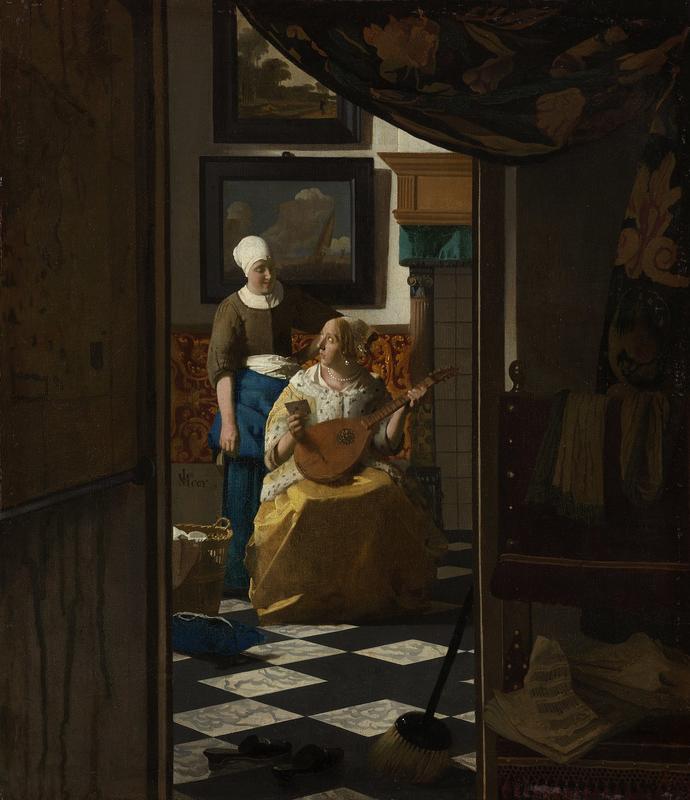More about The Love Letter
- All
- Info
- Shop

Editor
Is it really a Vermeer if it hasn’t been stolen at least once?
Like his Officer and Laughing Girl, Vermeer’s The Love Letter is sure to tickle a voyeur’s fancy, but it was also the subject of what is perhaps the biggest-hearted art theft in the entire history of art theft. Part of what made it a prime target for the five-finger discount was Vermeer’s timeless appeal. Basically, the painting depicts that nervous feeling you get when you receive an important text but are too afraid to unlock the screen and actually read the darn thing, only it does so in 17th century terms.
In a lit room glimpsed through a doorway, a maid interrupts her mistress’ cittern playing to hand her a letter. A knowing smirk plays on the maid’s face as she assumes a typically masculine pose with one arm akimbo. The seated mistress grips her cittern in trepidation, a hesitant, almost fearful look in her eyes as she takes the letter. Vermeer is capturing the briefest of moments, one of fleeting body language and drama, in which the maid actually becomes the mistress. The orderly existence of the mistress has clearly been upset. As evidenced by the overflowing laundry basket, the lacemaker’s pillow, and the broom, this lady has chores to be done that she has been neglecting. Come on, Petronella, this canal house ain’t gonna clean itself! Instead of helping her maid with housework, as was customary for Dutch gentlewomen, she seems to have been mooning about in love. The cittern and pages of music suggest a popular motif of harmony in love, and the paintings on the wall recall popular Dutch emblems and Petrarchan poetry also relating to love. The complex composition of the work positions the viewer as someone who is watching the scene unfold from an anteroom, separated from the main action by a barrier of a curtain, broom, and clogs on the floor. Perhaps the viewer takes on the role of the lover who has surprised his beloved? Perhaps the maid smirks because she knows he is waiting as she hands the mistress his compliments, and perhaps the mistress is anxious because her house is a big ol’ mess and now she has to entertain. We’ve all been there. At any rate, much of the pleasure derived from this painting is that of the voyeur--the joy of intruding unperceived on an intimate moment so quickly beheld it is gone, but is here preserved for lasting reflection.
The high quality of this artwork, and its rarity as a Vermeer, are part of what led to its being stolen. Unlike The Astronomer or The Allegory of Painting, which were taken as Nazi loot, The Love Letter wasn’t purloined until 1971, when it was stolen by a Belgian waiter named Mario Pierre Roymans. He hid in an electrical booth at the Fine Arts Palace in Brussels, where the work was on loan, and emerged after hours to grab the painting and bolt through an open window. When the frame proved too big to fit through the window, he quickly cut the painting out with a potato peeler and stuffed it into his pants. Does this make your heart hurt? It does mine. But Roymans did it because his heart hurt, too. A young idealist, he had seen images on tv of the 1971 Bangladesh genocide, a humanitarian crisis during which millions of people were raped and killed in the Bangladesh War for Independence, and he was so stirred by the horror of what he saw that he set a ransom for the painting with unique terms. His public demands included having the Rijksmuseum and Fine Arts Palace set up funds for combating world hunger, as well as 200 million Belgian francs being set aside for Bengali refugees who were suffering from starvation. Despite the fact that he gained the sympathy of the populace, who called for charges against him to be dropped, he was arrested with the aid of a sharp-eared wife of a gas station owner. And while his terms were not met, his crime did bring awareness to the horrors unfolding in Bangladesh and actually inspired many to form charities to benefit the refugees. Following his arrest and the recovery of the painting, Roymans served six months in prison, while the restoration of the damaged painting took over a year. The potato-peeler-painting-purloiner-with-a-purpose never struck again.
Sources
- Goodman, Elise. “The Landscape on the Wall in Vermeer.” In The Cambridge Companion to Vermeer, edited by Wayne E. Franits, 73-88. Cambridge: Cambridge University Press, 2001.
- Vergara, Lisa. “Women, Letters, Artistic Beauty: Vermeer’s Themes and Variations.” In Love Letters: Dutch Genre Painting in the Age of Vermeer, edited by Fronia W. Simpson, 50-62. Dublin: National Gallery of Ireland, 2003.
- Villa, Renzo. Vermeer: The Complete Works. Milan: Silvana Editoriale, 2012.
- Wheelock Jr., Arthur K. Jan Vermeer. New York: Harry N. Abrams, 1981.
- Wheelock Jr., Arthur K & Ben Broos, ed. Johannes Vermeer. New Haven: Yale University Press, 1995.
- “Vermeer Thefts: 1971 - The Love Letter.” Essential Vermeer. Accessed October 18, 2017. http://www.essentialvermeer.com/fakes_thefts_school_of_delft_lost_sp/ve…
Featured Content
Here is what Wikipedia says about The Love Letter (Vermeer)
The Love Letter (Dutch: De liefdesbrief) is a 17th-century genre painting by Jan Vermeer. The painting shows a servant maid commenting to her mistress on a letter the woman holds. The painting is in the Rijksmuseum Amsterdam.
Check out the full Wikipedia article about The Love Letter (Vermeer)














